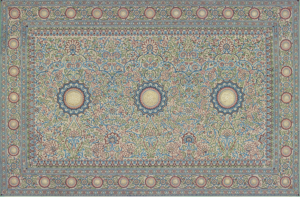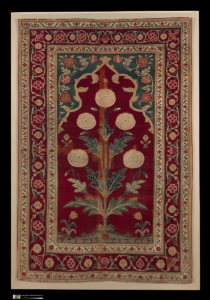If you step into a grand European palace, a stately American manor, or even a modern city apartment, there’s a good chance you’ll encounter a piece of Indian carpet adorning the floor. But what is it about these textiles that have captivated hearts and graced homes for centuries?
Well, Indian carpets are known for their long history, captivating beauty, and usefulness. In fact, carpet weaving has been a cherished art in India for ages, starting with the traditional Dhurrie-making and later evolving with influences from global carpet-making traditions.
In the beginning, all carpets were handmade by skilled artisans. The vintage Indian rugs we admire today are a testament to their craftsmanship. However, with the advent of the industrial revolution, machine-made carpets began to dominate the market, posing a challenge to handmade ones. Despite this, artisans persisted, infusing their creations with unique touches and intricate details that machines couldn’t replicate.
Handmade carpets came to symbolize luxury and elegance, each one a masterpiece crafted with care. In contrast, machine-made carpets often lacked the personal touch and were seen as more ordinary. Despite challenges throughout history, this art form has endured and evolved into the beloved tradition it is today.
Origin
In ancient India, there were no plush pile carpets like we have today. However, it was when the Mughals arrived around 1526, when a new era of carpet weaving was introduced to India. Mughals were used to fancier carpets from their homelands. Babur, the first Mughal emperor, really missed the beautiful gardens and fancy decorations from places like Samarkand and Persia. He tried to make India feel more like home, but it wasn’t quite the same.
It was actually Emperor Akbar who made a big change. He invited Persian carpet weavers to his palace in Agra and set up carpet weaving centers in Agra, Delhi, and Lahore. These centers became hubs of creativity and craftsmanship. The Mughals established royal workshops, employing skilled artisans who meticulously crafted carpets renowned for their:
- Exquisite Designs: Mughal carpets often depicted intricate floral motifs, geometric patterns, and even scenes from mythology. These designs were carefully planned, with court artists creating detailed cartoons (preliminary sketches) that served as blueprints for the weavers.
- Vibrant Colors: One of the hallmarks of Mughal carpets is their breathtaking use of color. Natural dyes derived from plants, insects, and minerals produced a dazzling array of hues, from the deep indigo obtained from the Indigofera plant to the fiery crimson extracted from lac insects. These natural dyes offered a depth and richness that synthetic alternatives simply cannot replicate.
- Unmatched Craftsmanship: Mughal carpets were hand-knotted, a time-consuming and meticulous process that involved tying individual knots onto a foundation warp. The density of the knots – the number of knots per square inch – determined the fineness and detail of the carpet. Skilled weavers could create carpets with hundreds of knots per square inch, resulting in breathtaking intricacy and unparalleled quality.
These carpets weren’t merely utilitarian objects; they served as potent symbols of wealth, power, and artistic excellence. They adorned the floors of royal palaces, served as valuable diplomatic gifts, and were even used as prayer rugs.
Evolution of Indian Carpets
Initially, the Persian carpet weavers brought their traditional style to India. However, over time, Indian artists began to incorporate their own unique elements into the Persian designs. This fusion of Persian and Indian styles created a distinctive look that gained popularity both within India and abroad. As more people sought these luxurious carpets for their homes, the blend of styles became a hallmark of Indian carpet weaving.
What set Indian carpets apart from their Persian counterparts was their asymmetrical patterns. Indian artisans drew inspiration from various sources, including Turkish designs, and infused these influences with their own creativity. This blend of styles and unique Indian elements gave rise to a tradition that is distinctively Indian.
The Allure of Craftsmanship
At the heart of Indian carpets’ enduring appeal lies the unparalleled craftsmanship that goes into their creation. There is no doubt that creating these carpets was a labor-intensive process, involving high-density knots and taking hundreds of hours to complete. Artisans used wool and silk, resulting in carpets that were not only beautiful but also luxurious to the touch.
Common designs included depictions of Mughal emperors, hunting scenes, and elaborate floral patterns. The Taj Mahal carpets, inspired by the iconic monument, were especially popular.
Another particularly stunning example of this craftsmanship is the Pearl Carpet of Baroda, commissioned in the 18th century by the Maharaja of Baroda. This extraordinary piece, adorned with over 1.5 million natural seed pearls, diamonds, and precious stones, showcases the pinnacle of Indian carpet-making artistry.
While this carpet is an extreme example, it illustrates the level of dedication and skill that goes into creating even more modest Indian carpets.

Major Carpet Weaving Centers in India
Following Akbar’s establishment of initial carpet weaving centers, the industry flourished and expanded, eventually leading to the prominence of three major states known for their exceptional craftsmanship in carpet weaving.
Kashmir
Carpet weaving in Kashmir began in the 15th century when the Sufi mystic Syed Ali Hamdani brought Persian weaving skills and craft knowledge to the region via the Silk Route. He arrived at the invitation of Emperor Zain ul Abadin, along with several skilled artisans. Over time, Persian designs blended with local flora and fauna, creating carpets with a distinct Indian style. The colors used in these carpets were also unique, thanks to the practice of using dyed yarns.
The Mughal emperors Akbar and Jahangir greatly supported the Kashmir carpet industry. Akbar’s patronage introduced new motifs like mythical animals and hunting scenes, while Jahangir’s support brought designs featuring natural plants and vines. Their encouragement helped the Kashmir carpet industry thrive and develop its unique artistic identity.
Uttar Pradesh
Bhadohi, Mirzapur, and Agra are key locations for hand-woven carpet production in Uttar Pradesh. Here’s a brief overview:
- Bhadohi: Known for producing the highest number of rugs in India, Bhadohi’s carpets come in various knot counts and designs. They specialize in hand-woven and hand-tufted shag rugs made of wool, often featuring intricate Persian designs. Bhadohi weavers are also skilled in Nepalese and Tibetan styles, sometimes incorporating historical monuments like the Taj Mahal into their carpets.
- Mirzapur: This city produces hand-knotted and hand-tufted carpets using wool and cotton. Mirzapur is famous for its Kilims and silk carpets, which often have Bohemian designs. The hand-tufted rugs, made with a tufting gun, are ideal for modern home decor and are widely exported.
- Agra: The carpet industry in Agra began under Emperor Akbar in the 16th century when Persian weavers were invited to teach local artisans. Agra carpets, known for their quality and often made with Pashmina wool, became famous. Even prisoners in Agra jail were taught carpet weaving, leading to the renowned Agra jail carpets. Similar weaving centers were later established in Amritsar, Lahore, Jaipur, and Gwalior.Akbar’s efforts even extended to reforming prisoners, who were taught the art of carpet weaving. Agra Jail carpets eventually became synonymous with quality, often using Pashmina wool to create the softest and most luxurious carpets. The Agra Jail carpets are a notable example of this initiative, showcasing how prisoners learned this skill and contributed to the art form.
Rajasthan
Rajasthan carpets are known for their strong knots and high-quality wool fibers. These hand-knotted carpets add a royal and luxurious look to any decor. The main centers for handmade Dhurrie rugs in Rajasthan are Jaipur, Ajmer, and Bikaner. Rajasthan carpets are versatile, available in both soft and hardback covers, and made from a mix of wool and silk. Despite their high price, their quality and craftsmanship make them worth it.
The Arrival of Indian Carpets in Europe and America
The allure of Indian carpets reached Europe during the 17th century, when trade routes expanded, and the East India Company began importing these exotic textiles. The European aristocracy and wealthy merchants were quick to embrace Indian carpets for their homes, seeing them as symbols of prestige and sophistication.
The intricate designs and luxurious textures of Indian carpets fit perfectly with the opulent decor of European palaces and estates. In fact, Queen Victoria received an Agra jail carpet as a gift when she became the Empress of India.
In America, the fascination with Indian carpets grew during the late 19th and early 20th centuries, coinciding with the Arts and Crafts movement. This movement emphasized traditional craftsmanship and the use of natural materials, making Indian carpets a perfect fit for the American aesthetic.
Prominent figures like Frank Lloyd Wright incorporated Indian carpets into their architectural designs, further cementing their place in American homes.
The Enduring Appeal in Western Homes
It is this timeless charm of the Indian carpets that has left an indelible mark across the globe! It continues to captivate homeowners in Europe and America due to several reasons:
Aesthetic and Functional Benefits
Indian carpets give any house a touch of class and elegance. With intricate patterns and vibrant colors, they can turn a dull space into a masterpiece. Besides their beauty, these carpets also provide practical benefits like warmth, comfort, and durability. That’s why they’re popular in European and American homes. Indian carpets are versatile and suitable for various interior design styles, from traditional to contemporary. They can be the highlight of a living room, bring coziness to bedrooms, or create a pleasant atmosphere in dining areas. Plus, their durability makes them perfect for busy households.
Cultural Appreciation and Authenticity
In Western homes, Indian carpets are gaining popularity for their cultural authenticity and diversity. These carpets have a special ability to tell a story and add a sense of history and global connection to a space. This reflects a growing trend of appreciating different cultures and incorporating ethnic and handmade products in home decor. Indian carpets, with their rich history and skilled craftsmanship, fit perfectly into this trend.
Historical Influence and Modern Trends
Indian carpets have fascinated the West for centuries. Since the 17th century, wealthy Europeans have coveted these carpets as status symbols. Today, our globalized world makes it easier to access diverse cultural goods, which only adds to the allure of Indian carpets. As of 2022, according to the Carpet Export Promotion Council (CEPC), India exported carpets worth approximately USD 1.37 billion , with the United States and Europe being the primary markets. The industry’s significance and its contributions to the worldwide market are highlighted by its economic impact.
Stories from the Loom
Behind every Indian carpet lies a story – not just of its creation, but of the people and cultures it touches. These stories contribute significantly to the carpets’ enduring appeal. Take Bhadohi, for example—a town in Uttar Pradesh known as the “Carpet City” of India. Families there have been passing down their weaving skills for generations, creating masterpieces that are both beautiful and durable.
Another example is the tale of the “Flower Carpet” that hangs in the Metropolitan Museum of Art in New York. This 17th-century woven piece belongs to a set of designs that were very popular when Shah Jahan was the emperor. The main picture on it is something people really liked back then: one flowering plant, which in this case is a poppy, inside an arched frame.

These woven pieces look a lot like the decorated panels used in tents and the fancy hangings you see in pictures of royal meetings. Because of this, we think people probably hung these up on walls instead of putting them on the floor like regular carpets.
The design is pretty simple: just one flower plant in a frame. But this simple look was very fashionable during Shah Jahan’s time. It shows how people’s tastes in art and decoration were changing back then.
Conclusion
Indian Carpets are a favorite among homeowners in Europe and America, seamlessly blending beauty with cultural richness. These timeless creations, skillfully made by artisans, add a touch of elegance and history to any modern home. By choosing these carpets, you not only bring home a piece of art but also support a centuries-old tradition and help preserve cultural heritage.
With their enduring charm, cultural significance, and positive economic impact, Indian carpets will undoubtedly continue to be cherished additions to homes around the world.

